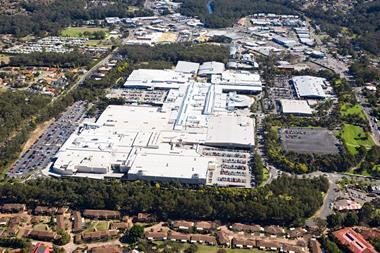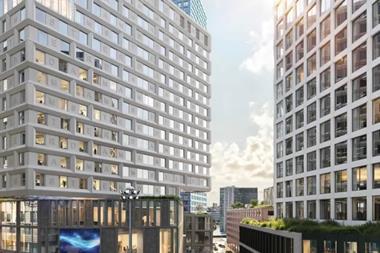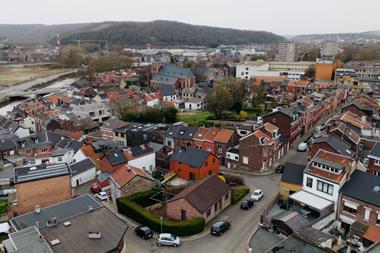As Asia's major centres struggle to meet the surge in investor demand the focus is moving to a vast tier of lesser ‘secondary' giants where huge potential combines with significant challenges. Paul Benjamin reports
Pune, Chongqing and Yokohama don't have quite the same ring as their more well-known siblings - globally recognised cities like Mumbai, Shanghai and Osaka - but anyone interested in the potentially more lucrative frontier edge of real estate might want to reach for an atlas.
As economic growth across Asia continues to surge and development consolidates in the main cities, capital and developers are looking to the lower secondary tier of cities for the next wave of development.
The debate about what distinguishes a primary city from a secondary and even a tertiary city could keep geographers, developers and economists arguing at the bar for weeks. Not to mention the politicians.
But in real estate terms two factors are critical - how many people live there, and how much money they make. When looking at China and India with their massive and rapidly urbanising populations, or at mountainous Japan with its very tight population density on the coast, it quickly becomes apparent that there are many cities that are huge by Western standards, and which have great real estate opportunities.
Take Chongqing in China, with a population of 30 million, which is enticing many Hong Kong developers, despite its relatively low per-capita income levels. The city is a fine example of a Chinese regional centre that will become an increasingly important administrative and industrial focus for a large south-western swathe of a vast nation. After all, not everything can be done from Beijing.
Most of China's provincial capitals will or do fall into this mould, including poorer spots like Nanchang and Changsha, but because economic growth has disproportionately benefited the eastern seaboard, clusters of promising secondary hotspots can be found in certain key industrial areas. A review by property consultants Knight Frank identified 57 cities with a population of more than 1 million and per-capita GDP above US$3,000 (€2,211). Fourteen of these were in the vital Yangtze Delta, nine in Guangdong province near Hong Kong, and six in Shandong province.
Paul Hart, executive director at Knight Frank in Hong Kong, says that although interest in the first-tier cities of Beijing, Shanghai, Guangzhou and Shenzhen remained strong despite government efforts to cool the property market, the limited availability of urban sites in the primaries was driving investor interest to secondary cities.
"Many foreign developers prefer residential projects in the secondary cities, and all in all the residential model in China is a good one. It's a very short play with a relatively quick payback period. Much of the financing comes from pre-sales and that's a very important part of the process.
"There's a huge demand for residential housing. Incomes are going up, the middle class is expanding, and aspirations are very high. The quality in the last three to four years has seen significant improvements, and the local developers have learned that quality matters."
But Hart says the desire for quality had not transferred into office sectors, especially once away from the demands of multinational tenants in the primaries. While local developers are improving, mistakes do occur, and Hart cited an example in the major city of Nanjing where research showed most tenants needed less than 150 m2, but a project was built where the smallest unit was 220 m2, creating an inbuilt redundancy.
He adds: "Companies aren't willing to pay for quality offices and don't care about lift lobbies and centralised aircon. Perception of quality will drive the market. That's happened in retail and residential, but not yet in office space."
He says that earlier mistakes made in poor retail design in primaries were largely disappearing with high-quality new builds in Beijing and Shanghai, but that faults such as low ceilings, or excessive levels of retail, are still being made in some secondary cities. Investors need to be sure they are backing projects that understand the needs of tenants and shoppers.
Chris Brooke, acting managing director of CB ¬Richard Ellis Investors in Beijing, agrees that interest in secondaries is picking up.
He says: "Over the last 12 to 18 months interest in second tier cities has become serious, but it depends what sector you're in. Much of the market is for mass market retail and residential.
"Our clients are taking us to cities like Chengdu, Tianjin, Hangzhou and Dalian. There's a lot of domestic and international interest and people want early mover advantage.
"Markets which are really strong include Chengdu, which is now the economic and service centre of the west, while Chongqing is a big manufacturing centre. Tianjin benefits from its proximity to Beijing and is the economic port city for the Bohai area.
"Hangzhou is seeing a lot of investment in leisure and tourism, and from companies moving their back offices out of Shanghai. The ports of Qingdao and Dalian, in Shandong province, are drawing a lot of investment from nearby Korea and Japan.
"Most of these cities have five to six million people and infrastructure is being developed very quickly, and national quality standards are being developed.
"Everyone talks about the China market but it's a very big place and there are lots of markets. Development is happening simultaneously but all the cities are at different stages. In what some may call the third tier, the big retail chains and fast food outlets are already there."
Outside of the primary cities the cultural issues that make business challenging can be compounded. Transparency of information remains a hurdle, and can be made worse by regional politics and regulations. But Hart says that sometimes the opposite is true: "Local authorities are sometimes more welcoming and you can get very good support at a local level."
Many of these concerns, particularly issues with regional bureaucracy and understanding the real local markets behind the illusion of a single national market, also apply to Asia's other rising giant - India.
Figures cited by Pramerica Real Estate Investors show that, thanks to foreign investment, strong consumer consumption and export growth, India and China will keep the entire region economically resilient, even if the US economy has a soft landing in the near future.
Although India's economy is a smaller US$780bn than China's US$2.3trn, growth rates in both economies over the next five years are set to continue on their fantastic annual trajectory of 10% and above.
But one differentiating factor between them which could have knock-on effect on real estate is infrastructure. Pramerica states that infrastructure investment in India is less than 5% of GDP, against a whopping 12% in China. The World Bank estimates that India must invest 3-4% more if growth is to be sustained.
Anshuman Magazine, managing director of CB ¬Richard Ellis, south Asia region, says that while infrastructure is an issue, the situation is improving.
"Expressways are now coming across the country and airports have been privatised, so we are seeing signs of improved connectivity. Some states and cities get power shortages, but less so."
Magazine says that it is important not to overplay the importance of secondary cities, as there are still many opportunities in the more established primaries of Delhi, Bangalore and Mumbai.
He adds: "There's activity going on all over the country and all the cities are growing. Take Bangalore, which has seen huge investment already but is not saturated yet. It's inevitable that secondary tier cities will come up, but I think it will take longer than people expect, perhaps four to five years."
Many of the major developments are linked with IT company growth and the boom in outsourcing that India has enjoyed. In fact, IT and IT enabled services account for 80% of total office space absorption. The IT companies often favour large out-of-town campuses and the quality of these has improved considerably. By contrast, office space in the CBD areas can be quite poor and difficult to redevelop, Magazine warns.
Meanwhile, Knight Frank identifies the key secondary cities as Kolkata in the northeast and, spread across the southern half of India: Hyderabad, Pune and Chennai. The company then highlights Chandigarh, Nagpur, Goa, Kochi and Visakapatinam as the next hot destinations further down the developmental scale.
Pune has benefited from its close proximity to Mumbai and demand for IT office space remains high, with recent take-ups including 3G and HSBC. Car manufacturers including VW and DaimlerChrysler have also secured land. In Hyderabad a shortage of quality CBD office space has led to a supply crunch and rents have risen sharply.
Kekoo Colah, executive director of Knight Frank in India, says the residential sector has flourished on a substantial rise in demand for housing, driven by the growth in India's new rich and middle classes, who are also enjoying low interest rates and incentives on home loans.
He adds: "This has been further fuelled by an increase in the earning population and the emergence of double income, nuclear families."
The same socioeconomic factors, greater urbanisation and rising disposable incomes have created demand for new retail and entertainment outlets of superior quality. Malls have mushroomed around many of India's cities. Tourism and leisure are also featuring, and it is noticeable that some of Knight Frank's tips are cities that have a strong tourism base, namely Goa and Kochi
Magazine also points to Trivandrum in Kerala, adding: "Trivandrum has seen strong growth in tourism and has been marketed successfully by the authorities. Some of the IT companies have set up there recently and non-resident Indians who are working in the Gulf are interested in property there."
India and particularly China have known only one economic speed in recent years - turbocharged. Japan, on the other hand, went through this period of catch-up growth when it restructured after the Second World War. Now one of the world's most advanced and mature economies, it offers a stark contrast to the upcoming giants.
First, Japan knows the downside of the property market, last experienced as a deep recession when the bubble burst in 1989. A decade of stagnation and recessions followed, but in 2003 the country started to recover. This differs from the China / India growth model as economic cycles in developed economies can leave secondary cities more exposed, as they can take longer to join in the upswing that starts in the primaries, and they can be harder hit by isolated issues - say, the demise of a particular industry.
Takeshi Akagi, associate director and head of research with Jones Lang LaSalle in Japan, says that the economy is currently doing well: "The Japanese market has been growing lively in recent years, and the price of property is rising on the back of the recovering economy."
He says prices started rising in Tokyo but that the demand has filtered through to the other primaries of Nagoya and Osaka. Investment competition has become intense in these locations, so secondaries that are also enjoying the upsurge include Sapporo, Sendai, Yokohama, Kyoto, Kobe, Hiroshima and Fukuoka. As with secondaries across the world, some of these are located near primaries, absorbing their spillover, while others are more remote regional centres.
Given its size and smaller population, Japan enjoys far greater geographic and socioeconomic consistency than India and China. The physical infrastructure is superb, as is the financial: J-REIT offerings have grown to 40 since the first was listed in 2001. Japan is a mountainous nation of individual islands and this has forced the population into a dense urban sprawl on the coastal plain, where many conurbations seem to run into the other. Akagi says an interesting case study is Sapporo, the regional capital of the northernmost island of Hokkaido.
"Branches and business offices of major companies that had been divided throughout Hokkaido are once again consolidating in Sapporo to streamline the organisation."
The city saw its first high spec Grade A office built last year, awakening latent demand. And it has been attracting more domestic and overseas tourists from Australia, South Korea and Taiwan for its winter snows, creating leisure and hotel opportunities.
Elsewhere in Japan competition for office space has been tight. Interestingly, and unlike some of its neighbours, Japan has much older office and residential stock which, instead of being pulled down, can be of strong enough fundamental quality to allow them to be redeveloped.
As with other secondaries, Hokkaido has seen decent residential growth. A lot of condominiums are being developed and built in the city, resulting in an increase of investment grade property. Although Japan's population is stabilised and largely urbanised, there is still migration into city centres, and household growth is growing, pushing demand for new homes.
Business optimism is good and the emergence of third-party logistics firms has led to demand for cutting-edge logistics facilities near airports and major cities. The economic expansion of the last four years has also led many foreign investors to back shopping centres and malls.
Overall, it seems that investors in Asia have much to look forward to, and the three countries considered here all promise solid growth over the coming years. In some markets, but particularly in China, there does seem to be a maturation of capital and opportunities in the biggest cities that is driving investors to the less obvious choices. Over the coming year, provided they have the right local partner on board and are tolerant of the risk implications, investors may do well to make secondaries more of a primary objective.












